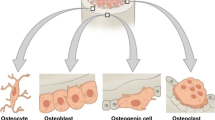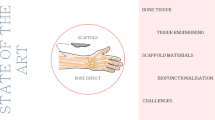Abstract
Relapse and metastasis of tumor may occur for osteosarcoma (OS) patients after clinical resection. Conventional metallic scaffolds provide sufficient mechanical support to the defected bone but fail to eradicate recurring tumors. Here we report that biodegradable magnesium (Mg) wire-based implant can inhibit OS growth. In brief, the Mg wires release Mg ions to activate the transport of zinc finger protein Snail1 from cytoplasm to cell nucleus, which induces apoptosis and inhibits proliferation of OS cells through a parallel antitumor signaling pathway of miRNA-181d-5p/TIMP3 and miRNA-181c-5p/NLK downstream. Simultaneously, the hydrogen gas evolution from Mg wires eliminates intracellular excessive reactive oxygen species, by which the growth of bone tumor cells is suppressed. The subcutaneous tumor-bearing experiment of OS cells in nude mice further confirms that Mg wires can effectively inhibit the growth of tumors and prolong the survival of tumor-bearing mice. In addition, Mg wires have no toxicity to normal cells and tissues. These results suggest that Mg implant is a potential anti-tumor scaffold for OS patients.
摘要
骨癌患者切除术后可能发生复发和转移. 传统的金属支架可 以对骨缺损部位提供力学支撑, 但无法有效清除复发的肿瘤细胞. 本文中, 我们介绍了一种可以抑制骨肉瘤生长的生物可降解镁丝 植入物. 简而言之, 镁丝释放镁离子激活锌指蛋白Snail1从胞浆到 细胞核的转运, 通过下游的miRNA-181d-5p/TIMP3和miRNA-181c-5p/NLK两条平行的抗肿瘤信号通路诱导骨肉瘤细胞凋亡, 抑 制骨肉瘤细胞增殖. 同时, 镁丝释放出的氢气消除了细胞内过多的 活性氧, 从而抑制了骨肿瘤细胞的生长. 裸鼠骨肉瘤细胞皮下荷瘤 实验进一步证实镁丝能有效抑制肿瘤生长, 延长荷瘤小鼠生存期. 此外, 镁丝对正常细胞和组织无毒性, 揭示了镁植入物是骨肉瘤患 者潜在的抗肿瘤支架材料.
Similar content being viewed by others
References
Ottaviani G, Jaffe N. The Epidemiology of Osteosarcoma. In: Jaffe N, Bruland O, Bielack S, eds. Pediatric and Adolescent Osteosarcoma. Boston: Springer, 2010
Siegel RL, Miller KD, Jemal A. Cancer statistics, 2018. CA Cancer J Clin, 2018, 68: 7–30
Eilber F, Giuliano A, Eckardt J, et al. Adjuvant chemotherapy for osteosarcoma: A randomized prospective trial. J Clin Oncol, 1987, 5: 21–26
Ritter J, Bielack SS. Osteosarcoma. Ann Oncol, 2010, 21: vii320
Ma H, Jiang C, Zhai D, et al. A bifunctional biomaterial with photothermal effect for umor therapy and bone regeneration. Adv Funct Mater, 2016, 26: 1197–1208
Han P, Cheng P, Zhang S, et al. In vitro and in vivo studies on the degradation of high-purity Mg (99.99 wt.%) screw with femoral intracondylar fractured rabbit model. Biomaterials, 2015, 64: 57–69
Lai Y, Li L, Chen S, et al. A novel magnesium composed PLGA/TCP porous scaffold fabricated by 3D printing for bone regeneration. J Orthopaedic Trans, 2014, 2: 218–219
Brar HS, Platt MO, Sarntinoranont M, et al. Magnesium as a biodegradable and bioabsorbable material for medical implants. J Miner Met Mater Soc, 2009, 61: 31–34
Witte F. The history of biodegradable magnesium implants: A review. Acta Biomater, 2010, 6: 1680–1692
Zhao D, Witte F, Lu F, et al. Current status on clinical applications of magnesium-based orthopaedic implants: A review from clinical translational perspective. Biomaterials, 2017, 112: 287–302
Zhang Y, Xu J, Ruan YC, et al. Implant-derived magnesium induces local neuronal production of CGRP to improve bone-fracture healing in rats. Nat Med, 2016, 22: 1160–1169
Zhang L, Pei J, Wang H, et al. Facile preparation of poly(lactic acid)/brushite bilayer coating on biodegradable magnesium alloys with multiple functionalities for orthopedic application. ACS Appl Mater Interfaces, 2017, 9: 9437–9448
Glasdam SM, Glasdam S, Peters GH. The importance of magnesium in the human body: A systematic literature review. Adv Clin Chem, 2016, 73: 169–193
Witte F, Kaese V, Haferkamp H, et al. In vivo corrosion of four magnesium alloys and the associated bone response. Biomaterials, 2005, 26: 3557–3563
Witte F. Reprint of: The history of biodegradable magnesium implants: A review. Acta Biomater, 2015, 23: S28–S40
Li G, Zhang L, Wang L, et al. Dual modulation of bone formation and resorption with zoledronic acid-loaded biodegradable magnesium alloy implants improves osteoporotic fracture healing: An in vitro and in vivo study. Acta Biomater, 2018, 65: 486–500
Wu Y, He G, Zhang Y, et al. Unique antitumor property of the Mg-Ca-Sr alloys with addition of Zn. Sci Rep, 2016, 6: 21736
Zhang Y, Ren L, Li M, et al. Preliminary study on cytotoxic effect of biodegradation of magnesium on cancer cells. J Mater Sci Tech, 2012, 28: 769–772
Chen Y, Xiao M, Zhao H, et al. On the antitumor properties of biomedical magnesium metal. J Mater Chem B, 2015, 3: 849–858
StJohn DH, Easton MA, Qian M, et al. Grain refinement of magnesium alloys: A review of recent research, theoretical developments, and their application. Metall Mat Trans A, 2013, 44: 2935–2949
Xia J, Chen H, Yan J, et al. High-purity magnesium staples suppress inflammatory response in rectal anastomoses. ACS Appl Mater Interfaces, 2017, 9: 9506–9515
Dole M, Wilson FR, Fife WP. Hyperbaric hydrogen therapy: A possible treatment for cancer. Science, 1975, 190: 152–154
Ishikawa K, Takenaga K, Akimoto M, et al. ROS-generating mitochondrial DNA mutations can regulate tumor cell metastasis. Science, 2008, 320: 661–664
Wang J, Witte F, Xi T, et al. Recommendation for modifying current cytotoxicity testing standards for biodegradable magnesium-based materials. Acta Biomater, 2015, 21: 237–249
Yang H, Zhang Y, Zhou Z, et al. Snail-1 regulates VDR signaling and inhibits 1,25(OH)-D3 action in osteosarcoma. Eur J Pharmacol, 2011, 670: 341–346
Yang H, Zhang Y, Zhou Z, et al. Transcription factor Snai1–1 induces osteosarcoma invasion and metastasis by inhibiting E-cadherin expression. Oncology Lett, 2014, 8: 193–197
Liu T, Yu J, Deng M, et al. CDK4/6-dependent activation of DUB3 regulates cancer metastasis through SNAIL1. Nat Commun, 2017, 8: 13923
Dominguez D, Montserrat-Sentis B, Virgos-Soler A, et al. Phosphorylation regulates the subcellular location and activity of the Snail transcriptional repressor. MCB, 2003, 23: 5078–5089
Han Y, Kuang Y, Xue X, et al. NLK, a novel target of miR-199a-3p, functions as a tumor suppressor in colorectal cancer. Biomed PharmacoTher, 2014, 68: 497–505
Wang N, Zhang CQ, He JH, et al. miR-21 down-regulation suppresses cell growth, invasion and induces cell apoptosis by targeting FASL, TIMP3, and RECK genes in esophageal carcinoma. Dig Dis Sci, 2013, 58: 1863–1870
Meng F, Glaser SS, Francis H, et al. Functional analysis of micro RNAs in human hepatocellular cancer stem cells. J Cellular Mol Med, 2012, 16: 160–173
Zhao D, Huang S, Lu F, et al. Vascularized bone grafting fixed by biodegradable magnesium screw for treating osteonecrosis of the femoral head. Biomaterials, 2016, 81: 84–92
Schmidt W, Behrens P, Brandt-Wunderlich C, et al. In vitro performance investigation of bioresorbable scaffolds—standard tests for vascular stents and beyond. Cardiovascul Revasculariz Med, 2016, 17: 375–383
Sezer N, Evis Z, Kayhan SM, et al. Review of magnesium-based biomaterials and their applications. J Magnesium Alloys, 2018, 6: 23–43
Qiao S, Wang Y, Zan R, et al. Biodegradable mg implants suppress the growth of ovarian tumor. ACS Biomater Sci Eng, 2020, 6: 1755–1763
Yang N, Gong F, Cheng L, et al. Biodegradable magnesium alloy with eddy thermal effect for effective and accurate magnetic hyperthermia ablation of tumors. Natl Sci Rev, 2020
Ohsawa I, Ishikawa M, Takahashi K, et al. Hydrogen acts as a therapeutic antioxidant by selectively reducing cytotoxic oxygen radicals. Nat Med, 2007, 13: 688–694
Ma N, Chen Y M, Yang B C. Magnesium metal—A potential biomaterial with antibone cancer properties. J Biomed Mater Res, 2014, 102: 2644–2651
Zhang X, Zu H, Zhao D, et al. Ion channel functional protein kinase TRPM7 regulates Mg ions to promote the osteoinduction of human osteoblast via PI3K pathway: In vitro simulation of the bone-repairing effect of Mg-based alloy implant. Acta Biomater, 2017, 63: 369–382
Leidi M, Wolf F, Maier JAM. Magnesium and cancer: More questions than answers. 2011, http://europepmc.org/abstract/MED/29920015
Schmitz C, Perraud AL, Johnson CO, et al. Regulation of vertebrate cellular Mg2+ homeostasis by TRPM7. Cell, 2003, 114: 191–200
Thiery JP. Epithelial-mesenchymal transitions in tumour progression. Nat Rev Cancer, 2002, 2: 442–454
Jung KH, Kim JK, Noh JH, et al. Targeted disruption of Nemo-like kinase inhibits tumor cell growth by simultaneous suppression of cyclin D1 and CDK2 in human hepatocellular carcinoma. J Cell Biochem, 2010, 110: 687–696
Zhou Q, Zheng X, Chen L, et al. Smad2/3/4 pathway contributes to TGF-β-induced miRNA-181b expression to promote gastric cancer metastasis by targeting TIMP3. Cell Physiol Biochem, 2016, 39: 453–466
Zhang A, Liu Y, Shen Y, et al. miR-21 modulates cell apoptosis by targeting multiple genes in renal cell carcinoma. Urology, 2011, 78: 474.e13
Kaufhold S, Bonavida B. Central role of snail1 in the regulation of emt and resistance in cancer: A target for therapeutic intervention. J Exp Clin Cancer Res, 2014, 33: 62
Chen GC, Pang Z, Liu QF. Magnesium intake and risk of colorectal cancer: A meta-analysis of prospective studies. Eur J Clin Nutr, 2012, 66: 1182–1186
Skrajnowska D, Bobrowska-Korczak B. Role of zinc in immune system and anti-cancer defense mechanisms. Nutrients, 2019, 11: 2273
Costello LC, Franklin RB. Cytotoxic/tumor suppressor role of zinc for the treatment of cancer: An enigma and an opportunity. Expert Rev Anticancer Ther, 2012, 12: 121–128
Costa da Silva M, Breckwoldt MO, Vinchi F, et al. Iron induces anti-tumor activity in tumor-associated macrophages. Front Immunol, 2017, 8: 1479
Acknowledgements
This work was supported by the National Key Research and Development Program of China (2018YFC1106600), and the Interdisciplinary Program of Shanghai Jiao Tong University (ZH2018QNB07).
Author information
Authors and Affiliations
Contributions
Zan R and Ji W designed the study and performed the cell experiments. Ni J, Wang W and Zhang S assisted in the animal experiment. Qiao S and Wu H prepared the Mg material. Zhang X and Yang B analyzed the data. Song Y and Ji T revised the manuscript.
Corresponding authors
Additional information
Conflict of interest
The authors declare that they have no conflict of interest.
Rui Zan is a PhD candidate at the State Key Laboratory of Metal Matrix Composites, School of Materials Science and Engineering, Shanghai Jiao Tong University (SJTU). His research focuses on the effect of biodegradable Mg and its degradation products on tumor cells.
Weiping Ji is an MD and PhD in the Department of Orthopedic Surgery, Affiliated Sixth People’s Hospital, SJTU, Shanghai, China. His research focuses on the clinical diagnosis and treatment of bone tumors and the design and development of orthopedic biomaterials as well.
Yang Song is currently working as an associate professor at the School of Material Science and Engineering, SJTU. He received his PhD degree from the University of Hong Kong (2011–2015) and later worked as a postdoctoral fellow at the University of Michigan (2016–2017) and Georgia Tech (2017–2020). His research interests focus on the design of biomimetic materials for biomedical applications, including synthetic liquid organelles, DNA-based microwebs for immunotherapy, as well as implantable and degradable medical devices.
Jiahua Ni received her PhD degree from SJTU. She has been working as a postdoctoral fellow in Mechanical Engineering at Massachusetts Institute of Technology since 2019. Dr. Ni’s current research interests include biodegradable magnesium medical devices and medical hydrogel.
Xiaonong Zhang is currently working as an associate professor at the School of Material Science and Engineering, SJTU. He completed his PhD degree from SJTU and was a postdoctoral fellow in the Department of Materials, Queen Mary University of London. His current research interests are metal matrix composites and biodegradable metals and devices.
Supplementary Information
Rights and permissions
About this article
Cite this article
Zan, R., Ji, W., Qiao, S. et al. Biodegradable magnesium implants: a potential scaffold for bone tumor patients. Sci. China Mater. 64, 1007–1020 (2021). https://doi.org/10.1007/s40843-020-1509-2
Received:
Accepted:
Published:
Issue Date:
DOI: https://doi.org/10.1007/s40843-020-1509-2




